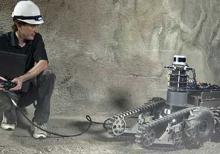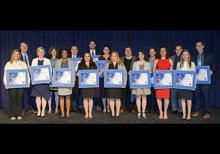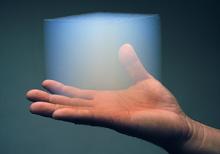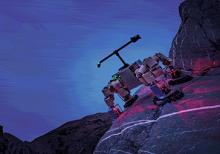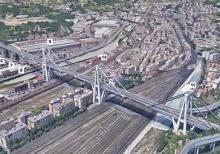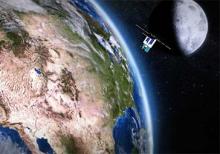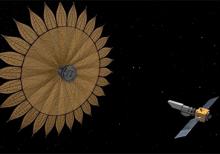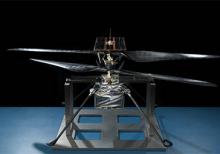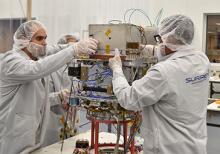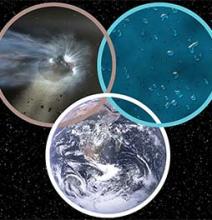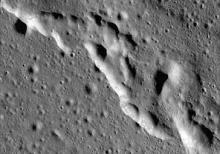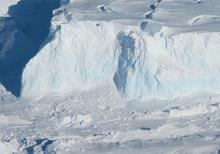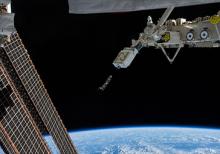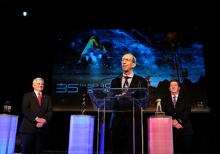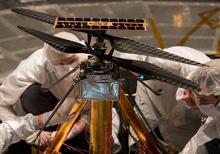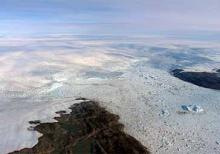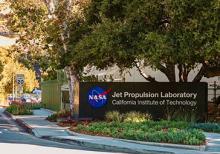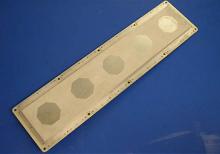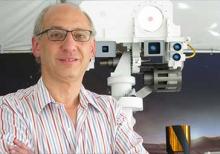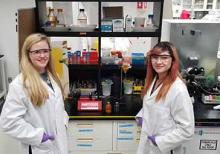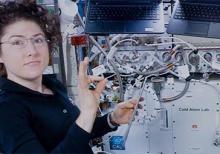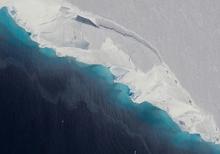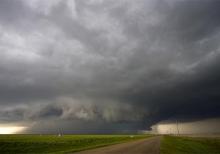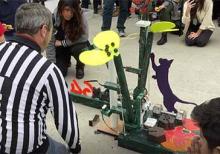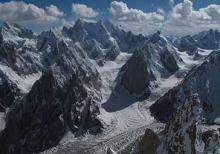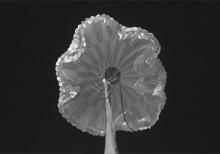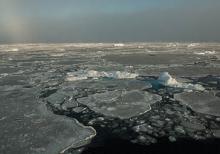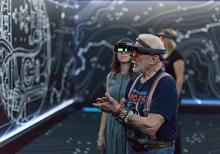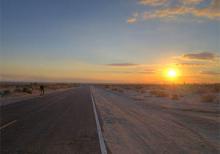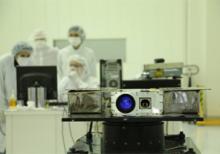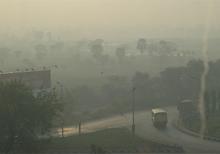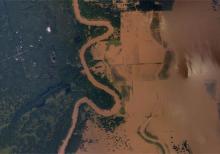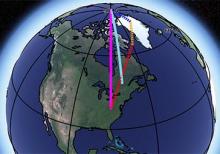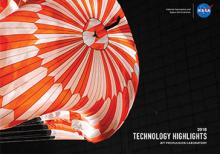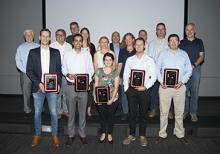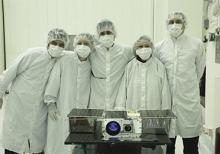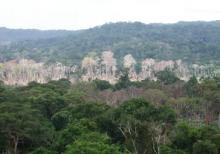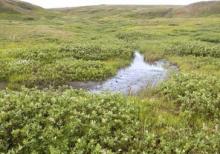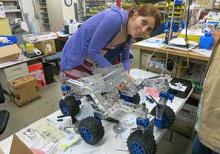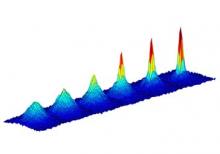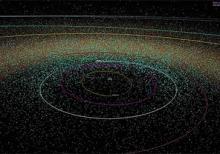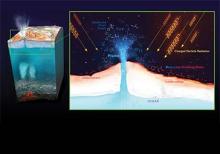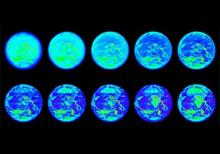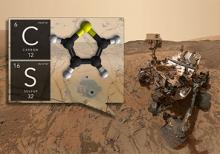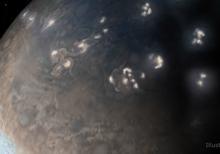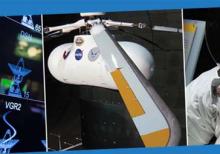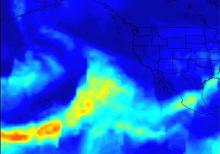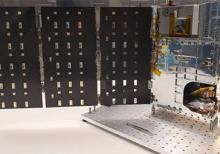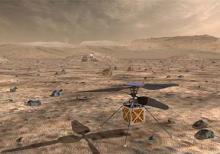The Media Relations Office at JPL is responsible for issuing press releases and hosting media events. As an institution, discussing new discoveries with the public is key to JPL's success as an institution. Below are selected press releases from JPL about new advances in many research fields.
News Board
Whether they fly, roll or do both, these machines could be the future of exploring beneath the surface of other worlds.
Three JPL researchers received the highest honor given by the U.S. government to scientists and engineers beginning their research careers.
Researchers are studying whether a wonder material used in Mars rovers could help warm parts of the Red Planet rich in water ice.
A new generation of robots being developed by NASA's Jet Propulsion Laboratory can crawl, walk and even climb cliffs.
Scientists have developed a technique for analyzing satellite data that can reveal subtle structural changes in bridges and other infrastructure.
JPL navigators Todd Ely and Jill Seubert fly rovers to Mars. Now the pair have a new mission: helping to develop a future in which spacecraft and landers navigate themselves.
To hunt for exoplanets, the flowerlike shade would need to stay aligned with a space telescope over vast distances. Recent work demonstrates how that's possible.
The Mars Helicopter - a small, autonomous aircraft that will demonstrate the viability of heavier-than-air vehicles on Mars - has passed several key tests with flying colors.
On June 22, NASA will launch a new technology that could change the way we navigate through space.
New observations reveal that water in comets and Earth's oceans may share common composition, suggesting more comets than previously thought could have delivered water to Earth.
High-resolution images show the Moon's lava plains are part of a much younger, shifting landscape than scientists realized.
How will Antarctica's melting ice sheet affect sea level rise hundreds of years in the future? Scientists now have a more accurate model to answer this question.
New technology that could support missions to the surface of Venus is one of many concepts chosen for the NASA Innovative Advanced Concepts program.
The historic mission is the 2019 winner of the John L. "Jack" Swigert, Jr., Award for Space Exploration.
More precise GPS, long-lasting sutures for heart surgery, and robots for disaster zones are among the spinoffs of inventions pioneered by NASA-JPL that benefit life on Earth.
The first helicopter to fly on Mars had its first flight on Earth.
Formerly the island's fastest-flowing glacier, Jakobshavn Glacier slowed dramatically when a nearby ocean current cooled, though it's still adding to global sea level rise.
The experimental program will develop technologies with startup companies for future space missions.
A satellite carrying a modified GNSS radio occultation receiver is showing how a small change in hardware could lead to a big change in science.
Being elected to the Academy is among the highest professional distinctions given to an engineer.
A team of scientists has re-created some of the first steps of life in the lab, testing whether life could emerge on other ocean worlds.
JPL-built CAL is an example of how doing things differently can help a project through difficulties and generate impressive results.
A NASA-led study has found a giant, growing cavern under Antarctica's Thwaites Glacier - just one of multiple mechanisms that are rapidly melting this enormous mass of ice.
A new NASA study shows that warming of the tropical oceans could lead to a 60 percent increase in the frequency of extreme rain storms by the end of the century.
Student teams raced against the clock — and one another — as they competed to be the first to stand a pipe upright using only homemade inventions.
Asia's high mountain glaciers are flowing more slowly as they melt, affecting the water supply of the arid plains below the peaks.
The supersonic parachute that will handle the heaviest payload yet to the Red Planet - Mars 2020 rover - passes its final sounding rocket test with flying colors.
The Arctic Ocean's sea ice blanket has already lost most of its old ice and two-thirds of its thickness. The younger ice is thinning more slowly and variably.
A mixed-reality software that allows scientists and engineers to virtually walk on Mars has received NASA's 2018 Software of the Year Award.
There's new evidence that a short section of fault in the California desert connects known faults in California and Mexico into one long, continuous system.
A partnership between JPL and MIT on the ASTERIA spacecraft has demonstrated CubeSat utility for astrophysics.
Smoke and human-caused pollution have different effects on the clouds that produce much of Earth's rainfall, a new study finds.
In a new NASA-led study, scientists used GPS data to track where Hurricane Harvey's stormwater went and how long it took to dissipate.
NASA has identified three processes responsible for wobbles in Earth's axis of rotation: water mass loss primarily in Greenland, glacial rebound, and mantle convection.
A new document presents a diverse set of technology developments -- selected by the Chief Technologist out of many similar efforts at JPL -- that are essential for JPL’s continuing contribution to NASA’s future success.
Winners of the annual 2018 Postdoc Research Day gave seminars on their research and were presented with plaques to commemorate the event.
The ASTERIA mission has received the Small Satellite Mission of the Year award for demonstrating "a significant improvement in the capability of small satellites."
A single season of drought in the Amazon rainforest can reduce the forest's carbon dioxide absorption for years after the rains return, according to a new study published in the journal Nature.
A new NASA-led study shows that the carbon cycle in the Arctic is speeding up.
The JPL Open Source Rover Project allows students and hobbyists to build their own scaled down version of NASA’s Curiosity rover.
The International Space Station is officially home to the coolest experiment in space: NASA's Cold Atom Laboratory is now producing clouds of ultracold atoms.
NASAs Center for Near-Earth Object Studies enters its third decade of predicting possible impacts.
New comprehensive mapping of the radiation pummeling Jupiter's icy moon Europa reveals where scientists should look.
A new study uses Earth as a stand-in for an exoplanet and shows that even with very little light -- as little as one pixel -- it is still possible to measure key characteristics of distant worlds.
NASA's Curiosity rover has found evidence on Mars with implications for NASA's search for life.
NASA's Juno spacecraft finds lightning on Jupiter is same as in Earth in some ways, opposite in others.
NASA has selected 304 proposals from U.S. small businesses to advance research and technology for future space missions, including 49 managed by JPL.
A new NASA-led study shows the events are likely to intensify, but become slightly less frequent, across most of the globe by the end of this century.
The next International Space Station resupply mission, launching this weekend, will carry three small satellites to test the next generation of Earth-observing technology.
NASA is adding a Mars helicopter to the agency's next mission to the Red Planet, Mars 2020.
Whether they fly, roll or do both, these machines could be the future of exploring beneath the surface of other worlds.
Three JPL researchers received the highest honor given by the U.S. government to scientists and engineers beginning their research careers.
Researchers are studying whether a wonder material used in Mars rovers could help warm parts of the Red Planet rich in water ice.
A new generation of robots being developed by NASA's Jet Propulsion Laboratory can crawl, walk and even climb cliffs.
Scientists have developed a technique for analyzing satellite data that can reveal subtle structural changes in bridges and other infrastructure.
JPL navigators Todd Ely and Jill Seubert fly rovers to Mars. Now the pair have a new mission: helping to develop a future in which spacecraft and landers navigate themselves.
To hunt for exoplanets, the flowerlike shade would need to stay aligned with a space telescope over vast distances. Recent work demonstrates how that's possible.
The Mars Helicopter - a small, autonomous aircraft that will demonstrate the viability of heavier-than-air vehicles on Mars - has passed several key tests with flying colors.
On June 22, NASA will launch a new technology that could change the way we navigate through space.
New observations reveal that water in comets and Earth's oceans may share common composition, suggesting more comets than previously thought could have delivered water to Earth.
High-resolution images show the Moon's lava plains are part of a much younger, shifting landscape than scientists realized.
How will Antarctica's melting ice sheet affect sea level rise hundreds of years in the future? Scientists now have a more accurate model to answer this question.
New technology that could support missions to the surface of Venus is one of many concepts chosen for the NASA Innovative Advanced Concepts program.
The historic mission is the 2019 winner of the John L. "Jack" Swigert, Jr., Award for Space Exploration.
More precise GPS, long-lasting sutures for heart surgery, and robots for disaster zones are among the spinoffs of inventions pioneered by NASA-JPL that benefit life on Earth.
The first helicopter to fly on Mars had its first flight on Earth.
Formerly the island's fastest-flowing glacier, Jakobshavn Glacier slowed dramatically when a nearby ocean current cooled, though it's still adding to global sea level rise.
The experimental program will develop technologies with startup companies for future space missions.
A satellite carrying a modified GNSS radio occultation receiver is showing how a small change in hardware could lead to a big change in science.
Being elected to the Academy is among the highest professional distinctions given to an engineer.
A team of scientists has re-created some of the first steps of life in the lab, testing whether life could emerge on other ocean worlds.
JPL-built CAL is an example of how doing things differently can help a project through difficulties and generate impressive results.
A NASA-led study has found a giant, growing cavern under Antarctica's Thwaites Glacier - just one of multiple mechanisms that are rapidly melting this enormous mass of ice.
A new NASA study shows that warming of the tropical oceans could lead to a 60 percent increase in the frequency of extreme rain storms by the end of the century.
Student teams raced against the clock — and one another — as they competed to be the first to stand a pipe upright using only homemade inventions.
Asia's high mountain glaciers are flowing more slowly as they melt, affecting the water supply of the arid plains below the peaks.
The supersonic parachute that will handle the heaviest payload yet to the Red Planet - Mars 2020 rover - passes its final sounding rocket test with flying colors.
The Arctic Ocean's sea ice blanket has already lost most of its old ice and two-thirds of its thickness. The younger ice is thinning more slowly and variably.
A mixed-reality software that allows scientists and engineers to virtually walk on Mars has received NASA's 2018 Software of the Year Award.
There's new evidence that a short section of fault in the California desert connects known faults in California and Mexico into one long, continuous system.
A partnership between JPL and MIT on the ASTERIA spacecraft has demonstrated CubeSat utility for astrophysics.
Smoke and human-caused pollution have different effects on the clouds that produce much of Earth's rainfall, a new study finds.
In a new NASA-led study, scientists used GPS data to track where Hurricane Harvey's stormwater went and how long it took to dissipate.
NASA has identified three processes responsible for wobbles in Earth's axis of rotation: water mass loss primarily in Greenland, glacial rebound, and mantle convection.
A new document presents a diverse set of technology developments -- selected by the Chief Technologist out of many similar efforts at JPL -- that are essential for JPL’s continuing contribution to NASA’s future success.
Winners of the annual 2018 Postdoc Research Day gave seminars on their research and were presented with plaques to commemorate the event.
The ASTERIA mission has received the Small Satellite Mission of the Year award for demonstrating "a significant improvement in the capability of small satellites."
A single season of drought in the Amazon rainforest can reduce the forest's carbon dioxide absorption for years after the rains return, according to a new study published in the journal Nature.
A new NASA-led study shows that the carbon cycle in the Arctic is speeding up.
The JPL Open Source Rover Project allows students and hobbyists to build their own scaled down version of NASA’s Curiosity rover.
The International Space Station is officially home to the coolest experiment in space: NASA's Cold Atom Laboratory is now producing clouds of ultracold atoms.
NASAs Center for Near-Earth Object Studies enters its third decade of predicting possible impacts.
New comprehensive mapping of the radiation pummeling Jupiter's icy moon Europa reveals where scientists should look.
A new study uses Earth as a stand-in for an exoplanet and shows that even with very little light -- as little as one pixel -- it is still possible to measure key characteristics of distant worlds.
NASA's Curiosity rover has found evidence on Mars with implications for NASA's search for life.
NASA's Juno spacecraft finds lightning on Jupiter is same as in Earth in some ways, opposite in others.
NASA has selected 304 proposals from U.S. small businesses to advance research and technology for future space missions, including 49 managed by JPL.
A new NASA-led study shows the events are likely to intensify, but become slightly less frequent, across most of the globe by the end of this century.
The next International Space Station resupply mission, launching this weekend, will carry three small satellites to test the next generation of Earth-observing technology.
NASA is adding a Mars helicopter to the agency's next mission to the Red Planet, Mars 2020.
